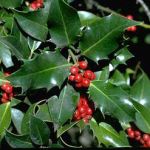| Common Name: |
English Holly |
| Botanical Name: |
Ilex aquifolium |
| Genus: |
Ilex |
| Family: |
Aquifoliaceae |
| Native Location: |
W and S Europe, N Africa, W Asia |
| Cultivation: |
Moist, well-drained soil in sun or shade. Variegated hollies need sun for optimum color. Ilex verticillata tolerates wet conditions. Cut back or trim in spring; clip formal specimens in summer. Prune I. paraquariensis into a low bush for ease of harvesting in the same way as tea (Camellia sinensis, See tea). Leaves may be damaged by holly leaf miner or leafspot. Transplant or repot with the root ball intact. |
| Propagation: |
By seed sown in autumn (species only); by semi-ripe cuttings in late summer or autumn. |
| Harvest: |
Leaves are picked in early summer (I aquifolium) and dried for infusions and liquid extracts. Leafy shoots (I. paraguarensis) may be picked at intervals throughout the year, in the same way as tea, and dried for infusions. Bark is peeled from twigs of I. verticillata in spring and dried for use in decoctions and liquid extracts. |
| Height: |
3-20m (10-70ft) |
| Width: |
8m (25ft) |
| Variations: |
Bacciflava
Is female with prickly leaves and yellow berries.
Height: 15m (50ft)
Width: 4m (12ft)
Ferox Argentea
(Silver Hedgehog Holly)
Is slower growing and male, with purple twigs and small leaves, which have creamy-white margins and spines over the entire upper surface.
Height: 6m (20ft)
Width: 4m (12ft)
Madame Briot
Is female, with purple-green twigs, scarlet berries, and large stoutly spined leaves that have irregular, bright yellow margins.
Height: 10m (30ft)
Width: 5m (15ft)
Pyramidalis
Is narrowly conical, self-fertile female cultivar with few or no spines and abundant red berries.
Silver Queen syn. Silver King
Is a slow-growing male cultivar with purple stems and broadly ovate, spiny, cream-edged leaves.
Height: 10m (30ft)
Width: 4m (12ft) |
| Hardiness: |
Z7-9 |
| Parts Used: |
Leaves |
| Properties: |
A bitter, astringent, tonic herb that is diuretic and lowers fever. |
| Medicinal Uses: |
Internally for malaria, bronchial complaints, influenza, and rheumatism. |
| Warning: |
Berries are harmful if eaten. |
| Bibliography: |
Encylopedia of Herbs by Deni Brown Copyright ©: 1995, 2001 Dorling Kindersley Limited pg 241
|
